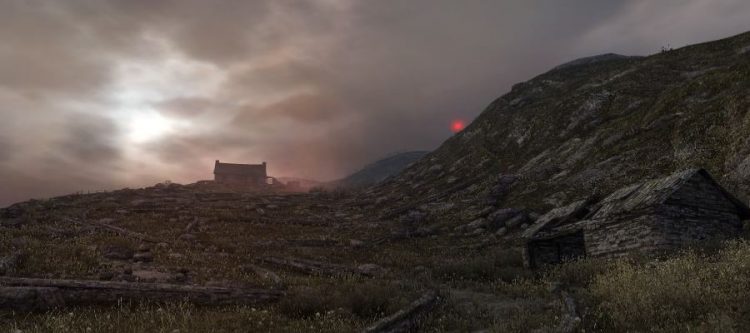
Dear Esther
Press ‘~’ key to enter developer console (must be enabled in Keyboard/Mouse options)
de_playerspeed – increase movement speed
default: de_playerspeed 100
faster: de_playerspeed 200
de_examinezoomamount – increase zoom amount
default: de_examinezoomamount 0.7
increase: de_examinezoomamount 0.4
sv_cheats 1 – enable cheats
mat_wireframe [0-4] – wireframe mode
Plot
The player progresses through Dear Esther by exploring an uninhabited Hebridean island, listening to a series of voiced-over letter fragments to a woman named Esther. The narrator’s identity is not specified, but there are suggestions he is Esther’s husband and that she is dead, killed in a car accident. These monologue fragments are triggered as the player reaches certain areas on the island and are chosen by the game semi-randomly, meaning that different playthroughs generate slightly different stories as certain readings are played while others inevitably get omitted. In his letters, the narrator refers to several other unseen characters. One, a cartographer named Donnelly, charted the island in the past. The narrator refers to Donnelly’s book frequently as he traverses the island. Another character the narrator mentions, Paul, is suggested to have been the driver in the car accident which killed Esther. The narrator also speaks of Jakobson, an eighteenth-century shepherd who lived on the island and whose life the narrator details.
The identities of the narrator, Esther, Paul, Donnelly and Jakobson become more blurred as the game progresses, as the narration moves between topics and relates the characters in different ways. The random selection of voice-over parts causes ambiguity and forces the player to draw their own conclusions of the story.
At the game’s end, the player reaches the radio mast atop the island’s peak and climbs a ladder to the top of the tower after a final monologue by the narrator, then jumps off and falls to the shore below. As the player falls, their shadow becomes that of a bird’s, and the player flies through the island’s bay before settling in front of an array of paper boats in the water.
Bible references
Later in the game, the readings begin to allude to the story of Paul on the road to Damascus, which is also the subject of some of the graffiti found painted on the cliff walls.
I believe nearly all, if not all of the sentences written around the game are quotes from the Bible, and from as far as I can tell, many are from the fifth book of the New Testament, the Acts of the Apostles, usually shortened to “Acts.”
In “The Caves,” there is a quote from Isaiah 17:1 (King James version):
Behold, Damascus is taken away from being a city, and it shall be a ruinous heap.
The quotes that appear near the end of the game are specifically referring to Paul the Apostle’s conversion (who was known as “Saul” before he converted) . They seem to be taken from different translations. In regards to the shift from third to first person, that is how his conversion was told in the Bible itself (Acts 9 was in third person, Acts 22 was Paul giving a speech about his experience, and is thus in first person).
The sentence written in the small shack on the way up to the cliffside is from Acts 9:3-4 (New Living Translation):
Acts 9:3 – …a light from heaven suddenly shone down around him.
Acts 9:4 – He fell to the ground…
The writing on the cliffside near the end is from Acts 9 and 22 (King James version) as follows:
Acts 9:9 – And he was three days without sight, and neither did eat nor drink.
Acts 22:6 – And it came to pass, that, as I made my journey, and was come nigh unto Damascus about noon, suddenly there shone from heaven a great light round about me.
Acts 22:11 – And when I could not see for the glory of that light, being led by the hand of them that were with me, I came into Damascus.
Before you get to this point in the game, you see shortened versions of these excerpts, like “I came into Damascus” and “neither did eat nor drink,” which is what was written on the side of the large boat you saw.
Ghost(s)
Sometimes on the island you can see an outline of a person/ghost. Also, some people suggest the player character is a ghost reliving his own version of an afterlife of regret, be that purgatory or hell. So the floaty feel of the camera added to the listlessness of his spirit wandering through his life of regret and loss. And it also added to the notion that he almost didn’t choose the ending of the game but was railed into following that course (as he might have done countless times over). Then again, to me this doesn’t make sense…a ghost with a flashlight…
Note: if you save and load up the game at the end (black screen) you see him staring up at the night sky at the two streaks of contrails.
Gaming Nexus – Dear Esther vs. The Bible – Article – by Randy Kalista